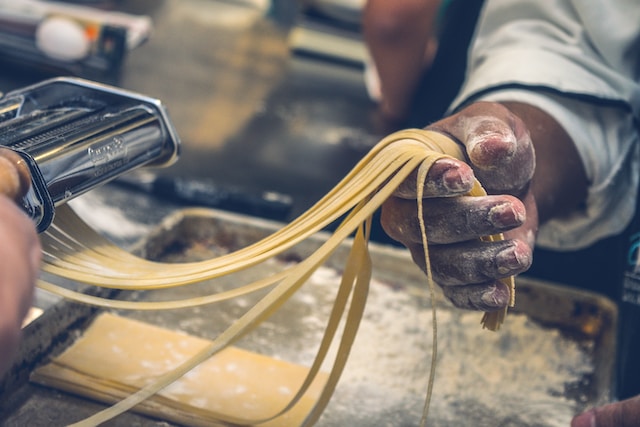I recently discovered, much to my astonishment, that even Italians make mistakes with their cuisine. While tourists may be excused, I think Italians who do so show an unacceptable lack of culinary culture, even if they’re dealing with dishes not native to their birthplace or region.
We’re so focused on criticising foreigners who order cappuccino with pizza in Naples that we never look at our own mistakes.
READ ALSO: Seven surprising Italian food rules foreigners fall foul of
It struck me how tricky the boundaries of regional cuisine can be. Italian cuisine varies so much by region that sometimes even Italians are shocked at what they are served. But if they’re unimpressed it’s because they’re ignorant of local food traditions.
I spent a few days last month in the region of Emilia Romagna, renowned for its delicious tagliatelle, lasagne and tortellini. I was staying at this high-end resort on the Colli Bolognesi (Bologna’s green hills) with full board.
I was shocked then to be served a slice of thick, stodgy pizza as a second course with fried potatoes. I called the waiter and he said it was one of their top specialties. The pizza was gluey, but what most stunned me was eating it not as a main, single course as usual, but as secondo after a plateful of tagliatelle al ragù – and for lunch.
In Italy, pizza at the pizzeria (as opposed to take-away pizza slices al taglio from small vendors) is made and served exclusively at dinner – and it’s not eaten after a dish of pasta.
RANKED: The 11 worst food crimes you can commit according to Italians
I felt like a foreigner who had mistakenly ordered pizza as a side dish, but this was a fixed four-course menu and I was at a seemingly traditional Bolognese tavern. My Neapolitan ancestors were probably turning in their grave. That sad pizza slice to me seemed like proof that even Italians are starting to mess with their food traditions.

The following day at lunch I was served plain polenta with a sticky, rough sauce which was meant to be crushed stockfish: my stomach later churned with nausea. Baccalà alla Vicentina is a typical Veneto recipe, not Bolognese, and the baccalà must be cooked for hours to make it tender and reduce the fishy flavour. There were also fried rectangular polenta sticks, a finger food normally eaten with a dipping sauce or butter, but these came without.
READ ALSO: Four myths about ‘traditional’ Italian food you can stop believing
For dinner I had plain polenta again (likely the leftovers from lunch) with what was meant to be Roman porchetta (roast pork). I’m no fan of porchetta, it’s greasy and hard to digest. But this one was sliced more like roast beef, and tasteless. It was not the traditional, thick porchetta served at I Castelli Romani, on Rome’s lush hills.
For dessert, I was treated to a fancy twist on cheesecake, instead of something more Italian like tiramisu or panna cotta.
But what shocked me was seeing that none of my friends or fellow diners sitting near my table were surprised at what they had been served – and all were Italian.
I think a cross-regional contamination is taking place. Italians are starting to play around with their food because their culinary heritage is getting weaker. The food ties that link them to their origin cuisine are getting lost, mainly because many families migrate to other places in Italy and assimilate local tastes.
OPINION: Michelin-starred cuisine is just not suited to Italy
A lot of foreigners are surprised to discover there’s not just one single cuisine in Italy, but regional twists and recipes they’ve never tasted, don’t expect in a certain area, or expect but can’t find. This is happening also to certain Italians who may have little culinary culture, or too much of it, and are taken aback with nasty surprises.
Territorial food boundaries are collapsing, alongside clichés. During my time in Bologna for instance I was never treated to a traditional lasagne, which is like going to Rome and missing out on carbonara pasta.
Once, in Sicily, instead of indulging in delicious ricotta-filled cannoli and cassata, the hotel restaurant I had picked, which mainly catered to foreigners, served French-style mousse au chocolat.
One reason for this degeneration is that many Italian restaurants tend to serve Italian or Mediterranean cuisine generally speaking to enrich their menus, appealing to more customers
But in doing so they make “un gran minestrone”, as my gran would say, meaning to blend a little bit of everything together so, in the end, no distinctive taste or food can be identified.
Italy’s regional cultural diversities are important, and should be preserved, but in some cases they seem to get lost in the mix.



 Please whitelist us to continue reading.
Please whitelist us to continue reading.
Guess staying in a tourist site it was to be expected the food would cater to the masses, which is exactly the same in the cities when eating around tourist sites. If you don’t want tourist food, you need to go into the suburbs for the traditional food of the region.